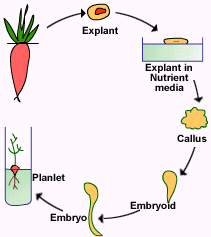Plant
Tissue Culture
In 1965, French botanist George
Morel was attempting to obtain a virus-free orchid plant when he discovered that
a millimetre-long shoot could be developed into complete plantlets by
micropropagation. This was the beginning of tissue culture. Thereafter, in the
1970s developed countries began commercial exploitation of this technology. It
entered the developing world in the 1980s. It was earlier used to develop
ornamental plants and flowering plants for export. With tree species, the
technique of tissue culture remained confined for many years to the laboratory
stage and had generally invited only academic interest. But in most developing
countries, the shortage of biomass and the ever-increasing energy requirements
created the need to explore possibilities of mass propagation of trees by tissue
culture.
Tissue culture or mass cloning
methods of elite tree species is done for increasing land productivity. They are
being modified or adapted for large-scale modification.
Species are selected for tissue
culture on the following basis.
 |
Species that have
regeneration problems, specially because of poor seed set or
germination (as in Anogeissus and bamboo). In these cases, seeds
collected from superior trees are used for initiating cultures. |
 |
Species that vary
markedly in their desirable traits, i.e. Eucalyptus. The selected
trees are marked from the variant population for the desirable trait
such as disease resistance, straight bole, higher productivity, etc.
in consultation with officials from state forest department or
growers. |
 |
Species where plants
of any one particular sex is of commercial importance, for example
female plants of papaya and male plants of asparagus |
In tissue culture cells, tissues,
and organs of a plant are separated. These separated cells are grown especially
in containers with a nutrient media under controlled conditions of temperature
and light. The cultured plant requires a source of energy from sugar, salts, a
few vitamins, amino acids, etc. that are provided in the nutrient media. From
these cultured parts, an embryo or a shoot bud may develop, which then grows
into a whole new plantlet. Similarly, portions of organs or tissues can be
cultured in a culture media. Generally, these give rise to an unorganized mass
of cells called callus (soft tissue that forms over a cut surface).
Tissue culture plantlets have
poor photosynthesis efficiency and lack the proper mechanism to control water
loss. They need to be hardened gradually by moving them along a humidity
gradient in the greenhouse. Once these plants are in the research fields, they
are evaluated under field conditions and the data is collected every 6 months. A
large number of tissue culture plants that have grown into trees are remarkably
uniform and show an increase in biomass production over the conventionally
raised plants.

Figure Tissue culture and
totipotency
Application of tissue
culture
 Micropropagation Micropropagation
Rapid vegetative multiplication of valuable plant material for agriculture,
horticulture, and forestry.
 Production
of disease-free plants Production
of disease-free plants
When the apex of shoot is used for multiplication by tissue culture, we get
disease free plants because the shoot apical meristem, a group of dividing cells
at the tip of a stem or root, is free from pathogens.
 Plant
breeding Plant
breeding
Tissue culture has also been successfully used in plant breeding programmes.
 Production
of disease- and pest-resistant plants Production
of disease- and pest-resistant plants
Plants grown from tissue culture usually pass trough callus phase and show many
variations. These show some agronomic characteristics like tolerance to pests,
diseases, etc.
Cloning
Genetically identical plants derived from an individual are called clones.
Processes that produce clones can be put under the term �cloning�. This includes
all the methods of vegetative propagation such as cutting, layering, and
grafting. Propagation by tissue culture also helps in producing clones. Using
the shoot tip, it is possible to obtain a large number of plantlets. This
technique is used extensively in the commercial field for micropropagation of
ornamental plants like chrysanthemum, gladiolus, etc. and also crops such as
sugar cane, tapioca, and potato. Thus an unlimited number of plants that are
genetically similar or are clones can be produced in a short span of time by
tissue culture.
Large-scale propagation
To bridge the gap between
research and application, the Department of Biotechnology, Government of India
sponsored the setting-up of two pilot-scale facilities for large-scale
propagation of elite planting material of forest trees through tissue culture.
One of these facilities has been established at TERI�s 36-hectare-campus in Gual
Pahari, Haryana with an annual capacity of a million plantlets. Research at
these facilities focuses exclusively on developing new protocols for mass
cloning of elite planting material, mainly of trees.
Till date, over 4 million plants
have been dispatched for field plantation from these facilities. The tissue
culture raised plants are presently being evaluated under field conditions. This
is being done in tandem with the forest departments of Haryana, Uttar Pradesh,
Madhya Pradesh, Bihar, Jammu and Kashmir, and Orissa. For initial screening for
phenotypically superior trees only a few hundred plantlets of the same are
raised and tested under various agroclimatic zones. The best clones are then
mass multiplied and monitored regularly for their performance. Field data
suggest a survival percentage of more than 90% even in the harsh conditions of
Aravalis without the life-saving irrigation. At half the rotation age some of
the selected clones of Eucalyptus are showing a significant increase in
productivity as compared to the conventional seed raised progenies.
|

